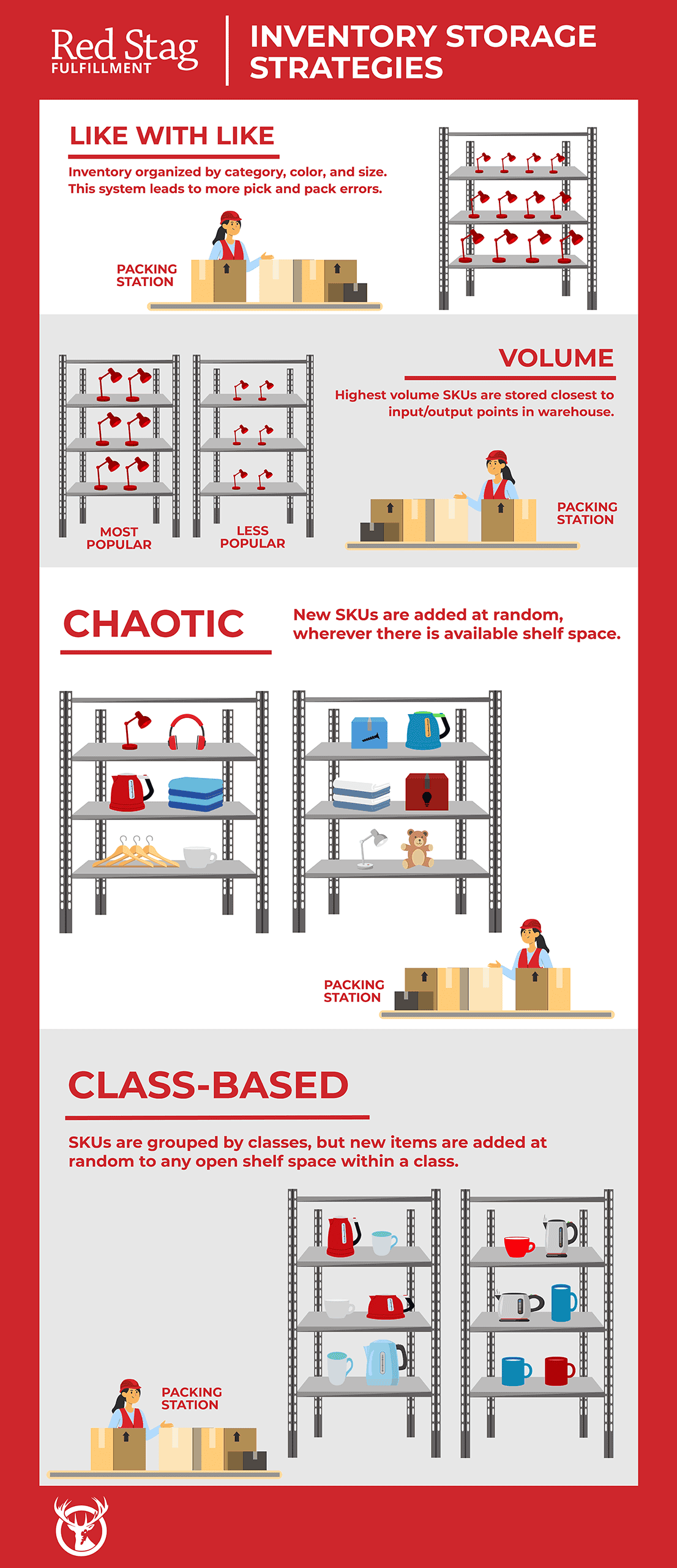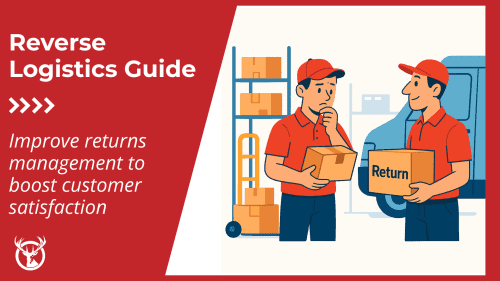The pick and pack process may seem straightforward, but your attention to detail can have a big impact on your cost, efficiency, and accuracy. That’s why it’s important to understand the best ways to organize your warehouse pick and pack process.
What is pick and pack?

Pick and pack is a fulfillment process where items are selected (picked) from inventory and then placed in a box (packed) for shipping.
There are four main steps to picking and packing. These steps also include additional ways you can achieve faster, more accurate fulfillment and warehouse operations.
01
Order receiving
02
Order picking
03
Order packing
04
Order shipping
Order receiving
01
When a customer places an order, your warehouse management system (WMS) generates a packing slip with the order details. The system assigns the order picking to a warehouse worker, who receives the packing slip.
Some systems require additional time before notifying your warehouse team. And that might be okay for some situations, so long as we’re talking minutes, not hours. Integration of omnichannel sales and warehouse management platforms is crucial for efficient pick and pack fulfillment and customer satisfaction.

PRO TIP: Ecommerce fulfillment is most efficient when your systems are integrated for real-time information exchange. This means your ecommerce sales channels connect with your warehouse system immediately, notifying warehouse staff to take action.
Order picking
02
Staff walk or drive warehouse machinery to the appropriate shelves where ordered items are stored, select the desired quantity of each item, and verify the picking list for accuracy. The picking process may vary somewhat across warehouses based on size or inventory.

PRO TIP: There are a few specific picking method options that 3PLs or warehouse staff may employ to make the process faster. These relate to how inventory is organized within the warehouse.
Order packing
03
Picked orders go to packing stations, where staff pack and seal items in boxes using the best method for each particular product. They label boxes, check for accuracy, and hand the package off for staging and carrier pickup at loading docks.

PRO TIP: Using the right packing materials may help control shipping costs. For items priced by standard weight, using the right boxes and infill creates cost-efficiency. For large or heavy items priced by dimensional weight, compact packing techniques keep costs as low as possible.
Order shipping
04
Staff consolidate packages in staging areas near loading docks and move them to a specific dock door when a carrier truck arrives to pick them up for customer deliveries.

PRO TIP: Carrier networks and pricing may vary, but you can help minimize shipping costs by choosing pick and pack fulfillment warehouse locations that are central to the majority of your customers. Inland warehouses may be better for reducing landed costs and ensuring timely deliveries.
Picking and packing methods
As your ecommerce business grows, you may have to evolve your warehouse picking and packing methods to meet demand.

Startups and early-stage companies may get away with picking items one at a time.

When you sell more, advanced warehouse picking methods create speed.

Your pick and pack system should match your inventory and order complexity.
Here are a few pick and pack processes to consider.
Piece picking
Team members pick one order at a time and take the items to a packing station. Piece picking works well for small businesses with only a few daily order picking requirements.
Batch picking
The batch picking method organizes orders into groups based on where items are in the warehouse. This allows team members to pick more orders at once and typically requires a WMS to guide staff on when to pick items and from where. Small and large companies with higher customer orders can benefit from batch picking.
Zone picking
Zone picking increases complexity but helps with speed. Pickers work specific warehouse zones, moving items across them all so items can be organized by order ahead of delivery to a packing station.
Zone picking suits businesses with a high volume of customer orders and high SKUs per order. Staff uses a WMS to stay coordinated, especially because zone picking paths may change as inventory updates.
Wave picking
Wave picking is when warehouses combine batch picking and zone picking, moving batches across zones. This method is the most complex but allows the greatest efficiency and can save money over time. Wave picking is for high-performing businesses with thousands of monthly orders and high SKU volumes.

Pick and pack warehouse setup
How you organize your warehouse is called “slotting.” It’s a warehouse operations strategy that manages how fulfillment teams minimize warehouse travel and search time. Identifying the most efficient route through a warehouse helps speed up the pick and pack fulfillment process.
At a high level, this may include tactics like making sure popular items aren’t too close together, where they may cause traffic jams. At the SKU level, it may include making sure visually similar items are separated to avoid picking errors.
Efficient path instructions may also help reduce errors, contributing to accurate and timely order fulfillment. Let’s review a few common approaches.
Chaotic inventory management
It’s easy to assume the most logical storage is to put similar items together. But this style of pick and pack management can actually cause slowdowns and errors.
For example, if the medium black dress is next to the large black dress, it’s easy to grab the wrong one. Chaotic inventory management disrupts the assumptions and errors anyone can make when items look alike.
With this system, storing the medium black dress near the gray baseball caps or pink sweaters makes more sense. The visual contrast helps with picking accuracy.

NOTE: This approach relies on advanced inventory management software to guide pickers to items. It’s too much for someone to remember, especially since new product introductions are likely to update item slotting and warehouse systems.
Volume inventory management
Volume inventory storage places the SKUs with the highest turnover closest to the packing station. Products that sell the slowest are stored in the farthest location. This minimizes the steps staff take when order picking.
Class-based inventory management
With class-based inventory management, you group items by shared traits, like turnover or packing methods. For example, you may group products that all need bubble wrap or large items that don’t require an additional box.
Mobile shelf-based order pick systems
Some warehouses may use mobile shelf-based order pick (MSOP) systems. This is where robots bring shelves to the picker and then return them to the warehouse floor.
Order packing best practices
As items move into packing, having the right processes in place can help make sure your pick and pack order fulfillment drives customer satisfaction.
Remember, this is a last chance for warehouse packing teams to check picking accuracy, making sure the right quantities of the right items go in the box before it’s sealed and shipped.
Accuracy at this stage may help reduce the risk of returns, which incur reverse logistics and restocking costs and may disappoint customers.
Now, let’s explore some of the pack strategies you can use to optimize your pick and pack service for a streamlined fulfillment process and cost-efficient shipping.
Use the right-sized box
Using boxes that are too big winds up costing you more in shipping costs than you’d otherwise have to pay. Boxes that are too small may lead to damages during shipping.
But using the right-sized box helps optimize carrier costs and may help prevent expensive returns or loss. Whether you use branded packaging or not, make sure every box is the right size.
Protect items with infill
Infill, like shredded cardboard and packing peanuts, provides cushioning and helps prevent items from shifting in boxes during shipping. For larger items, you may need custom infill, including molded inserts or a mix of infill types.
Appropriate packing materials keep items safe. Branded infill can complement branded packaging.
Use the right tape
There are multiple types of packing tape, including filament tape, duct tape, and reinforced gummed tape. Each serves a different purpose. For example, you may use filament tape for extra strength or reinforced gummed tape for strength and environmental sustainability.
How you apply tape matters, too. Some boxes need taped corners to avoid crushing. Some packages require multi-directional taping tactics.
Optimize for dimensional weight
Some products may have different shipping price structures. If you ship large or heavy items, you may be subject to dimensional weight pricing, which measures the size of a package to calculate a weight equivalency. Compact packaging may reduce your pick and pack fee based on packaging materials and your dimensional weight for cost savings on shipping.
Kitting
Kitting is a specialized kind of pick and pack service. Your warehouse assembles various SKUs into a different, single SKU to create a subscription pack or promotional bundle. Packing for kitting may require adjusting warehouse packing techniques monthly or as new promotions arise.
Pick and pack software
For picking and packing to go smoothly, each step must happen in coordination with the others.
Fulfillment center staff need to know who is handling which orders and when items are ready to flow to the next stage. Ecommerce store owners and leadership need visibility into pick and pack services, including overall workflows, fulfillment status, and productivity.
Inventory and warehouse software solutions, including your warehouse management system, tie this information together.
When starting a partnership with a 3PL, their warehouse management software may determine the complexity of your setup and integrations. Make sure you first understand what it takes to be onboarded with them before moving forward.
How pick and pack software works
Take a look at this overview of how pick and pack software connects warehouse activity and communication.
- Order integration
Software connects to sales channels and receives new orders. - Picking
Staff receive picking lists and optimized paths on mobile devices, allowing them to see item details, locations, and quantities. Team members can monitor pick completion progress in real-time, identifying potential bottlenecks and adjusting workflows as needed. - Packing
Picked items are scanned. Packing tasks are assigned based on weight, size, and order requirements. Packers receive alerts for missing or incorrect items, allowing for immediate intervention and error correction. - Shipping
The software generates shipping labels with accurate weight and address information, streamlining the dispatch process. Teams can track shipped orders in real-time, providing updates to customers and improving communication.
The connectivity provided by warehouse management software supports your pick and pack fulfillment by acting as a source of truth for workflow progress. It also automates certain tasks, like picking assignments, order status, and other aspects of communication.
Integrating pick and pack process data
When reviewing software specifications, keep in mind the importance of interoperability and integrations. All of your systems should connect to support effective supply chain management.
If certain systems don’t connect, you end up dealing with data silos. Silos are datasets that lose their analytical value because they can’t be analyzed in context with the rest of your operations.
Real-time inventory visibility prevents stockouts and overstocking, ensuring products are readily available for pick and pack fulfillment without wasted capital. Consider some of the ways your pick and pack data might impact your ecommerce business as a whole:

Integrated data can inform targeted promotions and upselling opportunities, enhancing customer engagement and satisfaction.

Real-time order tracking allows for communication of potential delays or issues, helping to manage customer expectations effectively.

Integrated data systems can readily adapt to fluctuating order volumes and product offerings, ensuring smooth operations during growth phases.

Tracking key metrics lets you identify areas for improvement and optimize the picking and packing process and other warehouse operations.

Outsourcing pick and pack
As you discover the intricacies of the pick and pack process, you may decide it makes more sense to outsource operations to a 3PL.
3PLs are strategic partners that can help with the picking and packing process, labor costs, shipping, and other supply chain considerations.
A key indicator for outsourcing is fluctuating order volumes. When order quantities vary seasonally or due to market trends, a 3PL’s flexibility allows for scalable and cost-effective solutions. Rapid growth can also make outsourcing a viable option to prevent internal logistics from becoming a bottleneck.
The expertise and infrastructure of a 3PL can enhance order accuracy, reduce errors, and streamline the order fulfillment process.
Cost considerations play a crucial role in the decision-making process, too. A 3PL may be able to provide a favorable pick and pack fee based on order fulfillment and SKU volumes.
Outsourcing eliminates the need for substantial upfront investments in pick and pack warehouse space and other resources. This shift to variable costs provides financial flexibility and allows businesses to allocate resources strategically.
Keeping up with the competition
As ecommerce evolves, big box retailers and marketplaces like Amazon are defining customer experiences and expectations. You’re competing with companies that can provide same-day and next-day delivery on millions of items. A 3PL can help you scale up the resources required for greater competitive advantage.
Technological advancements in 3PL services, such as real-time tracking and good inventory management systems, also contribute to increased visibility and control, making outsourcing to a 3PL a practical solution.
Pick and pack guide summary
Mastering the pick and pack process is pivotal to your success, creating a substantial list of benefits for your business.
As your business evolves, so should your warehouse picking and packing processes. You can grow into new picking strategies, starting with piece picking and moving into more advanced methods like wave picking.
Slotting and warehouse organization both support picking, too. A chaotic inventory management system may help improve picking times and reduce errors. Combined with other slotting techniques, this may help optimize the picking process.
Then, an optimal packing method may help achieve low landed costs and high customer satisfaction. Best practices may streamline shipping processes and minimize costs, and software ties it all together, providing visibility.
For companies facing uneven demand, rapid growth, or cost challenges, outsourcing pick and pack operations to a 3PL is a strategic move. The advancements offered by 3PLs may make your business more competitive as major retailers and marketplaces set customer expectations.
Improve your pick and pack
Ready to improve your warehouse picking and packing? At Red Stag Fulfillment, we can help you optimize your operations for cost, speed, efficiency, and insights.
Our strategically located order fulfillment centers can ship to 96% of U.S. homes within two days, and our services are backed by 100% accuracy and 0% shrinkage guarantees.
Reach out today to start a conversation.









